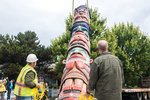When you’re walking downtown Port Townsend, driving out to Fort Worden or looking for sea glass at North Beach County Park, remember what used to be there.
For hundreds of years the …
This item is available in full to subscribers.
We have recently launched a new and improved website. To continue reading, you will need to either log into your subscriber account, or purchase a new subscription.
If you had an active account on our previous website, then you have an account here. Simply reset your password to regain access to your account.
If you did not have an account on our previous website, but are a current print subscriber, click here to set up your website account.
Otherwise, click here to view your options for subscribing.
* Having trouble? Call our circulation department at 360-385-2900, or email our support.
Please log in to continue |
|


When you’re walking downtown Port Townsend, driving out to Fort Worden or looking for sea glass at North Beach County Park, remember what used to be there.
For hundreds of years the S’Klallam people lived in the village of “qatáy,” located in what is now Port Townsend.
They fished for seafood, harvested plants like native blue camas, and carved canoes for travel.
Today, there are many remnants of this period of time, if you know where to look.
That is why the Native Connections Action Group of the Quimper Unitarian Universalist Fellowship, in partnership with the Jamestown S’Klallam Tribe, created the Chetzemoka Trail in Port Townsend—to educate the public on the relationship between the S’Klallam people who had lived for hundreds of years in what was once called “qatáy,” and the European settlers who arrived in Port Townsend in the mid-19th century.
The interpretive trail highlighting 18 historically significant sites throughout Port Townsend has signs that offer historic information about Chief Chetzemoka (pronounced Cheech-ma-han; later changed by settlers to Chetzemoka) and the S’Klallam people of the 19th century, as well as the impact of the arrival of European settlers and connections to present-day S’Klallam people.
The trail follows the life of Chief Chetzemoka, who is one of the best-remembered S’Klallam leaders because he befriended the early Port Townsend settlers and helped the S’Klallam negotiate the difficult changes in their lifeways.
“Settlers and the indigenous peoples of the North Olympic Peninsula area have worked diligently to coexist and develop respectful relations despite their cultural differences,” wrote Ron Allen, Tribal Council Chairman with the Jamestown S’Klallam Tribe in a message about the new trail. “Chief Chetzemoka played a key role in establishing this relationship in the 19th century. … Today in the 21st century, our S’Klallam and sister Tribes continue to strive to work together to solve problems in a complex society, respecting the values of both the indigenous and the non-indigenous populations of the area.”
The trail divides into three loops: a 3-mile loop, a 6-mile loop, and a 12-mile loop. The 3-mile loop is easily walkable and features downtown historical sites, such as Point